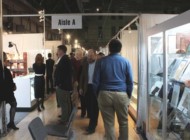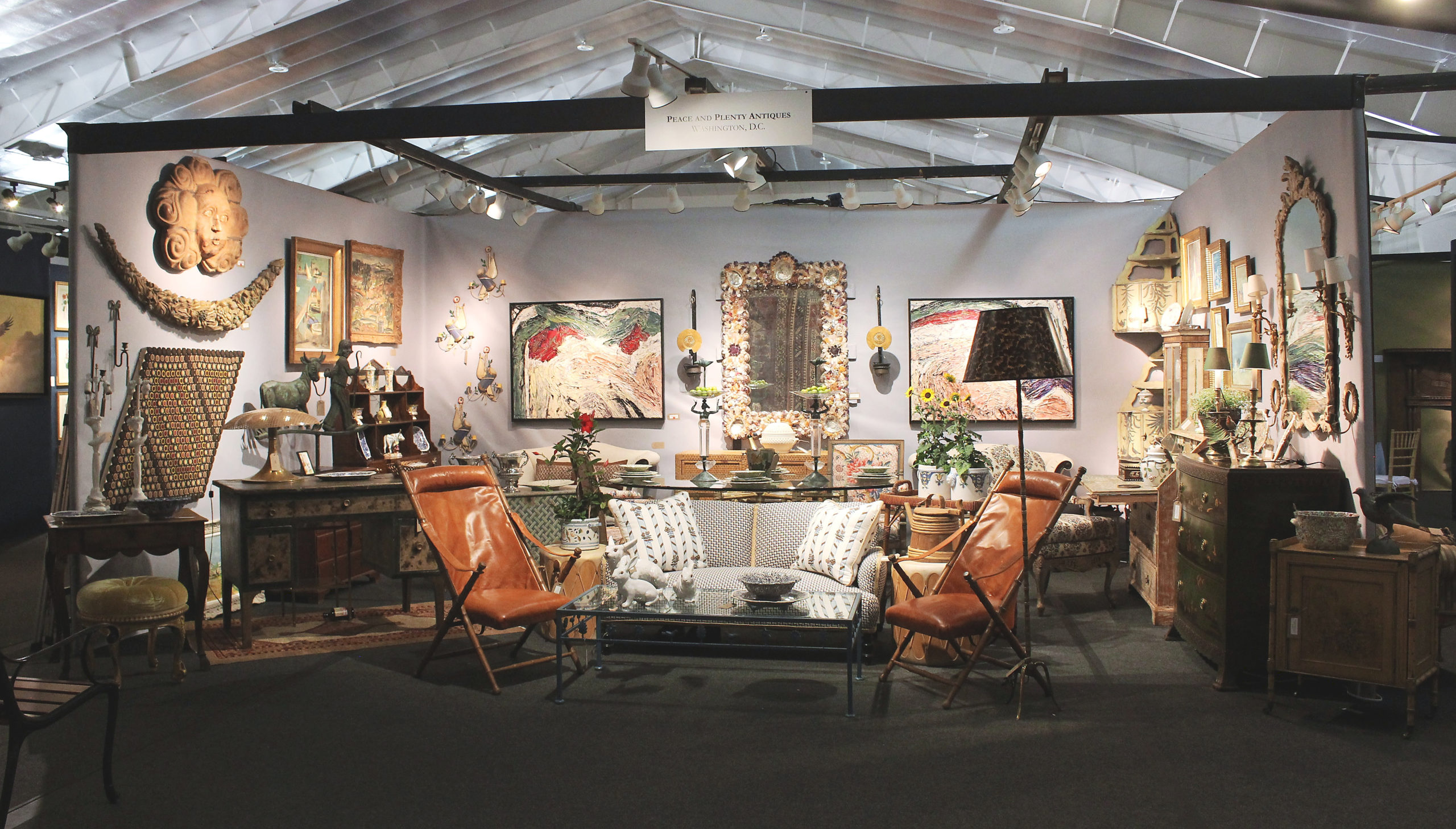
Peace and Plenty Antiques enjoys some peace and quiet before Saturday shoppers swell in its booth.
Review & Photos by Z.G. Burnett
MIDDLETOWN, R.I. — The Newport Show premiered this season with a Gala Preview Party on July 28, followed by two days of public admission on July 29 and 30. Described as “a high point of the summer social season,” the show’s vendors delivered with a diverse array of fine art, antiques and other wonders that superbly exceeded visitors’ expectations. “Sold” stickers were dotted throughout the venue’s 35 booths and on Saturday, many exhibitors reported healthy sales at the premiere, especially of merchandise that could be carried out in shopping bags. Although the venue was an ice rink at St George’s School, the overall layout and general presentation of each individual booth caused many to forget this logistical factor. As a fundraiser for the Newport Historical Society and the Boys & Girls Club of Newport County, more than 500 guests attended the preview, and the show raised a record-breaking $375,000.
Visitors were greeted by art and objects in “Access Newport,” a collaborative exhibition featuring artwork from New England artist Bob Knox, interspersed with historic artifacts from the Newport Historical Society’s collection. Knox’s paintings “build a story using everything from classic objects, interior design and historic art references to engage and invite the viewer into his private world.” One such image was “Mrs Drexel Lehr,” after Giovanni Boldini’s portrait of “Mrs Elizabeth Lehr” and her dog, Hippodale (1905). Knox showed this painting in situ at Newport’s Elms mansion, which once neighbored Lehr’s “Newport Cottage” estate of Arleigh, since demolished. With the inclusion of chairs and architectural elements, Knox provides his specific perspective of the painting, which is less detailed than the details surrounding it, showing the viewer its color palette in precisely placed brushstrokes.
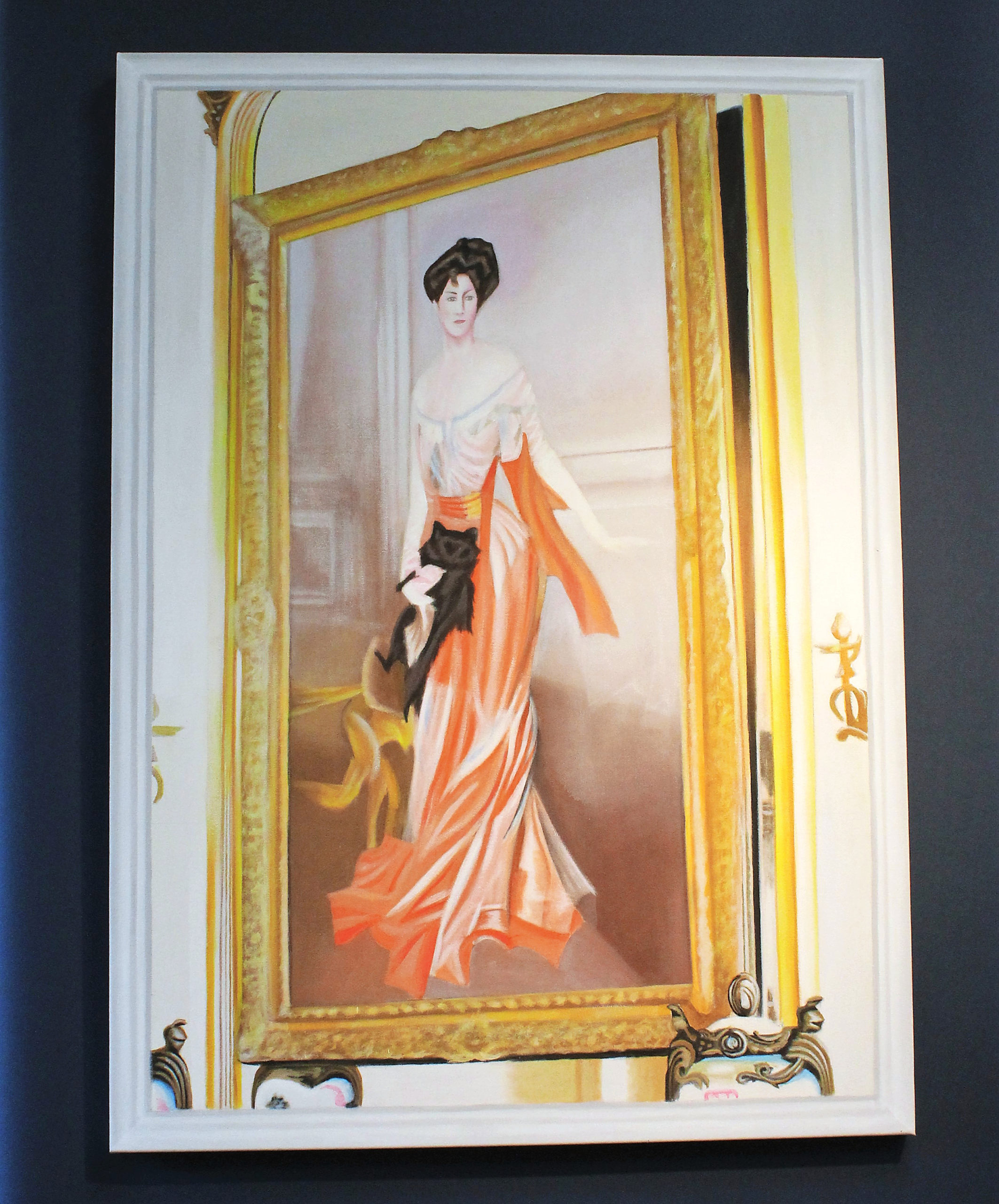
“Mrs Drexel Lehr,” Bob Knox after Giovanni Boldini, Connecticut, part of the “Access Newport” collaborative exhibition. For inquiries, newport.curates@gmail.com.
One of the largest booths was occupied by Shaia Oriental Rugs, Williamsburg, Va., with a wealth of new and antique carpets of every size and description. An unusual addition to the piles of kilim, heriz and more was an Afghani carpet woven with sea creatures. Although “not old,” the unique rug was distinctive for its inclusion of a shark and an orca. Shaia was also offering Indian carpets woven with schools of fish, turtles and other sea creatures.
Imperial Fine Books brought an extensive catalog of recent acquisitions and rare volumes, which formed a handsome anchor in their display of other encased antiques. Dating from the early Nineteenth Century, Imperial offered single tomes as well as multi-volume sets. Titles included an 1891 edition of Famous Women of the French Court by Imbert de Saint-Amand (Charles Scribner’s Sons, New York City) in 19 volumes, a 30-volume set of the works of Charles Dickens, illustrated throughout by H.K. Brown and published in 1900 (Chapman & Hall, London), and Edgar Allan Poe’s complete works in a limited edition that was signed by both the editors and the publishers. Known as the Edition des Amateurs and one of only 26 printed, the set included more than 50 full-page illustrations. These and Imperial’s other offerings were bound in Morocco leather with gilt-tooled lettering, banding and decoration, as well as marbled endpapers.
Francis J. Purcell Antiques, Philadelphia, cornered the market with architectural elements, creating an almost surreal arrangement of cast iron, wood and other indoor and outdoor decorative arts. An especially striking piece was an extremely rare American white pine fan-carved mantelpiece, made in New York’s Hudson Valley circa 1810-20. Combining the Dutch and English cultures found in this region, the mantelpiece showed three fan paterae with more on the side sinkages, vassa columns separating these and fronting the mantel jambs, as well as a chip and fan carved belt course of molding. It was cleaned of old paint buildup and had only some repairs; potential buyers only needed a fireplace and wall big enough to accommodate its 91-inch length. This was grouped with a midcentury cast iron tilt top table signed by “Rudy Groeger” and a painting of two snacking squirrels with a bird by Susan Catherine Waters (American 1823-1900). Waters began her career as a portraitist in the New York-Pennsylvania border region, later gaining recognition for her animal subjects that were often allegorical.
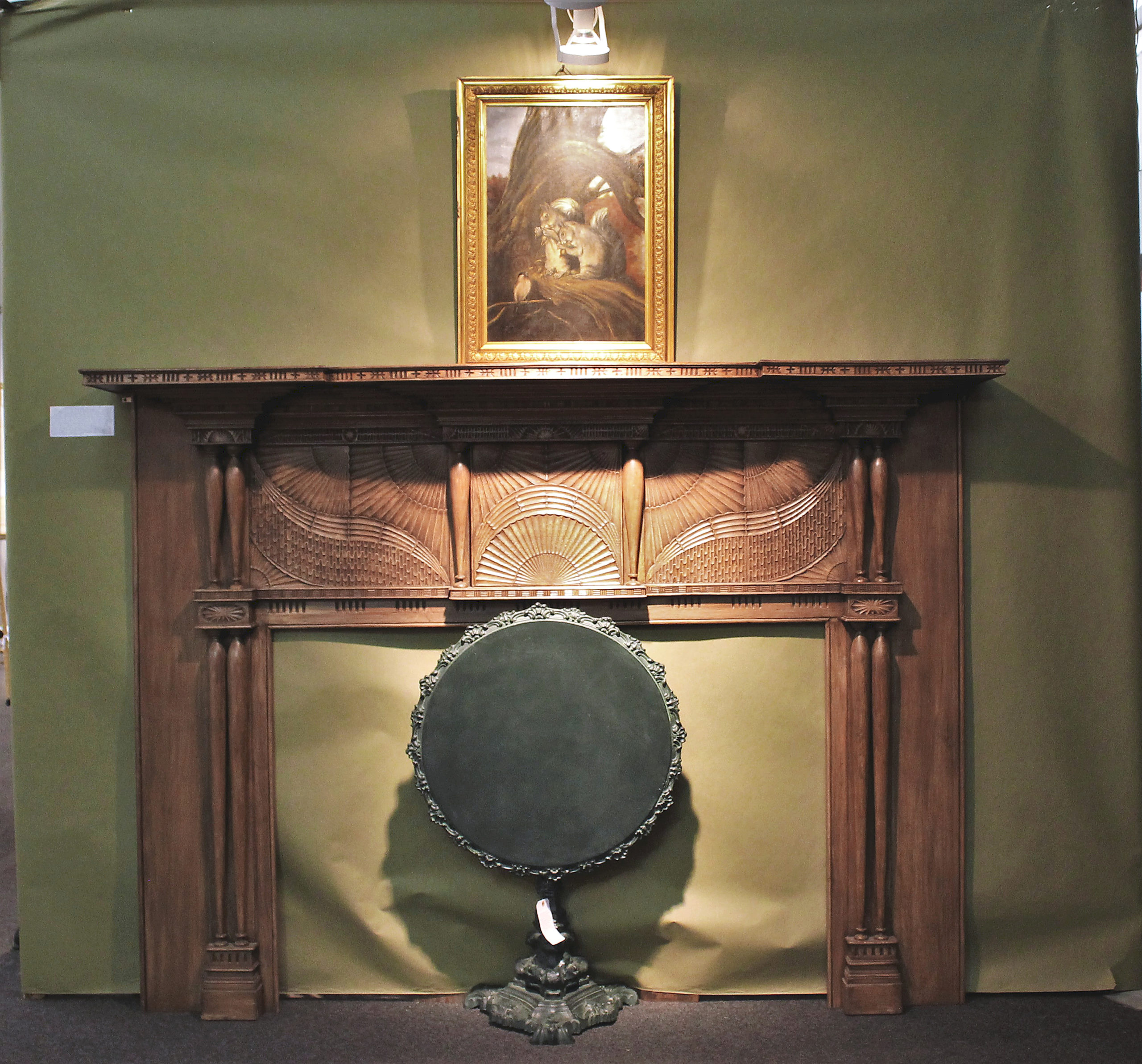
This rare Hudson Valley white pine mantelpiece was intricately carved throughout; it was accompanied by a midcentury cast iron table and a possibly allegorical painter by Nineteenth Century America artist Susan Catherine Waters. Francis J. Purcell Antiques, Philadelphia
Find Weatherly, Westport, Conn., also showed some large, striking pieces, including a late Nineteenth Century French eel trap, handmade from wire. The trap was fresh to market, as it was formerly used as a hanging lamp! Two other large pieces in Find Westerly’s display was a pair of 1980s reed chaises longues by Filipina designer Betty Cobonpue, who designed furniture with “never a hard edge.” Find Weatherly had a second pair of these available from the “Sculptura” line.
Another, earlier piece of Midcentury Modern furniture was paired with fine art from the same period on the booth of Dinan & Chighine, London. Crafted from mahogany and rosewood, the “Double Helix” sideboard was designed by David Booth and Judith Ledeboer for Gordon Russell, London, in 1954. The sideboard retained its original maker’s label. Hung above this were original color lithographs by Le Corbusier from the 1955 series “Le Poème de L’Angle Droit,” published by Tériade. These were signed and numbered, six out of a rare edition of 60 on Arches wove paper, and offered separately.
Earlier furniture was also available in abundance for collectors with more traditional inclinations. Jayne Thompson Antiques, Harrodsburg, Ky., combined fine and country furniture to create an elegant but comfortable tavern-like space in their booth. The centerpiece of this was a rectangular oak gate-leg table with double swing legs that supported each leaf, creating an unusual silhouette when half closed. The table was made in England around 1750, with well-figured grain and a warm, well-used color.
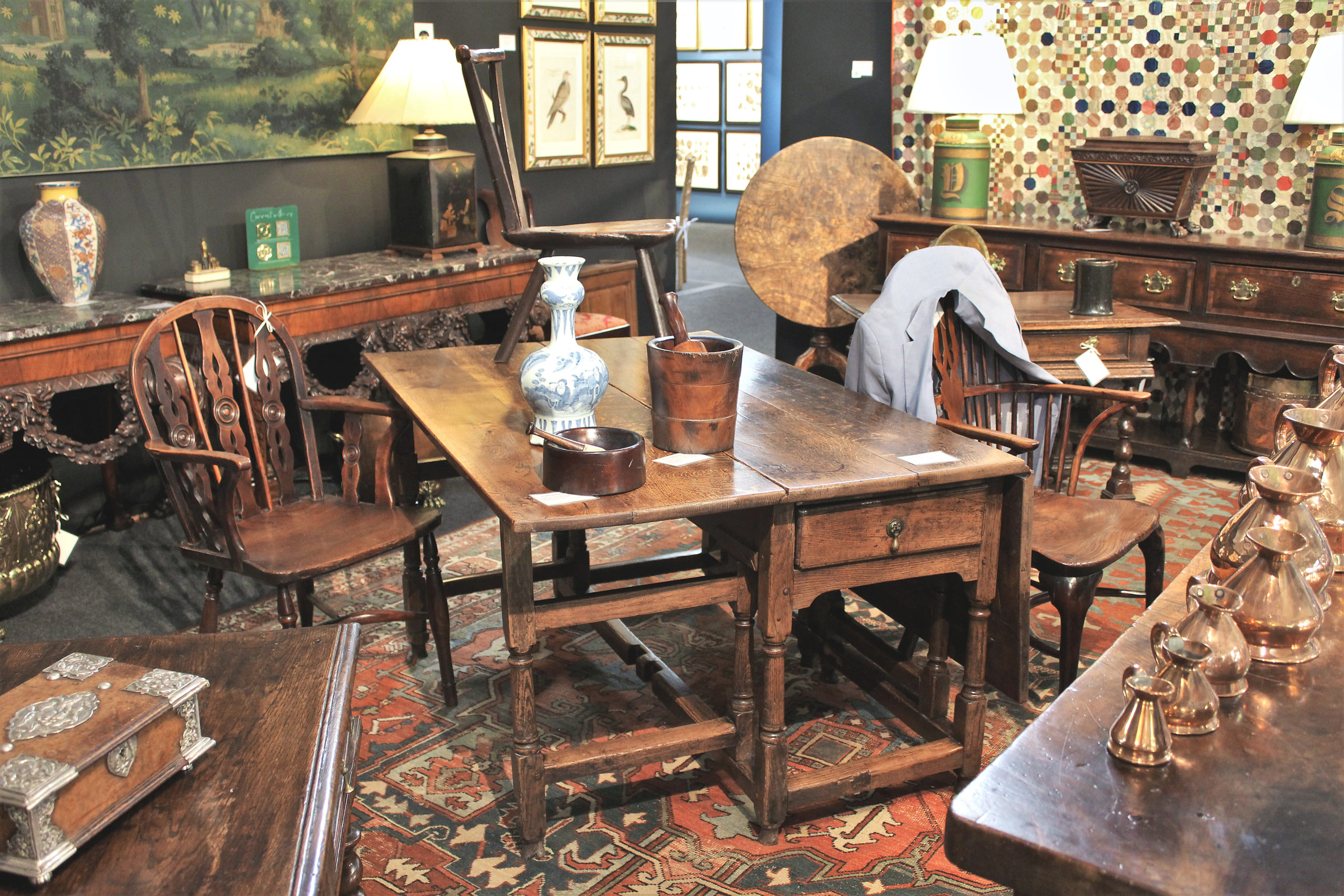
Jayne Thompson Antiques, Harrodsburg, Ky., created a welcoming atmosphere in its space with warm brown furniture, gleaming vases and copper measuring cups, a few sets of which were spotted throughout the show.
Next to Thompson’s booth was the space of Diana H. Bittel Antiques, which was more sparsely decorated but its contents presented no less quality. The booth’s centerpiece was a walnut two-drawer Chippendale blanket chest from Chester County, Penn., prettily inlaid on its front surface with a bird perched on flowering branches. Atop this was a Nineteenth Century weighted zinc eagle with spread wings, flanked by two rare Napoleonic watch hutches that were both crafted by prisoners of war. Made with bone and tools for which these craftsmen would trade goods during supervised prisoner interactions, each are marvelous examples of what one may accomplish with nothing but time. The hutches were carved with columns, swags, lattices and even figural sculptures.
One standout booth required a wide angle to capture it completely, as it was decorated primarily with sailor’s woolworks, or “woolies.” The booth was organized by Earle D. Vandekar, Downingtown, Penn., who presented a guide to the woolies displayed, and Bittel, who wrote an accompanying article for the exhibition. Woolies were typically made with Berlin wool on duck, a type of linen, and began to appear around 1850 when aniline dye was created. At the time, Saxon wool was far superior to British wool, and sewing kits were available with instructions for patterns from slippers to furniture seating. Sailors adopted this model from its intended target, women, and primarily focused on ships as subjects to keep their hands busy when they were not needed on deck.
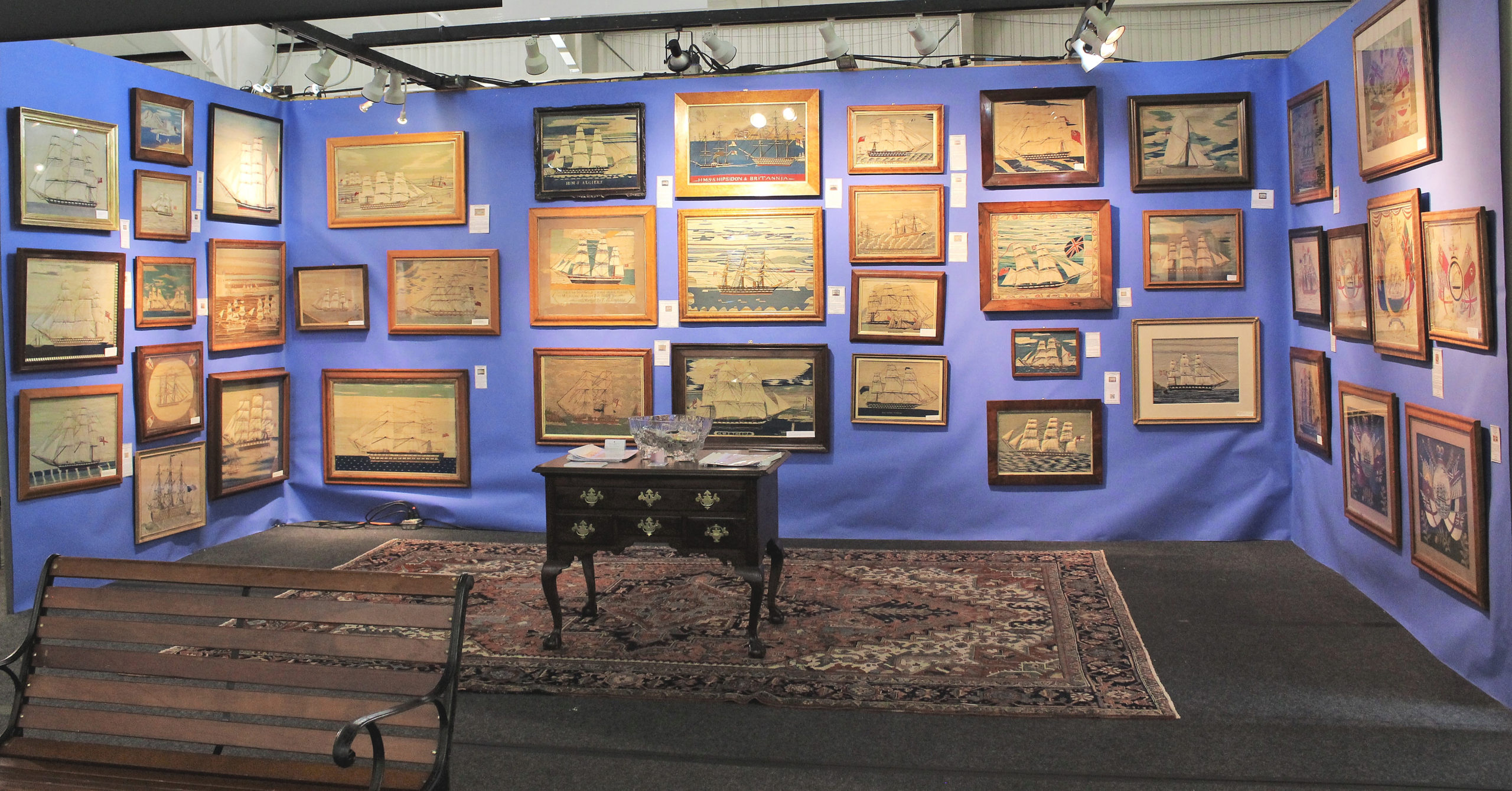
Bittel & Vandekar’s British Sailor’s Woolwork Exhibit, showing examples that dated from the 1860s, complete with a catalog and article on the medium.
Fine art was also well represented with both living and historic artists. Zachary Hall presented a signed pencil on paper sketch by John Singer Sargent, titled “Study off Newport, Rhode Island,” from 1876. Appropriate to the show, the sketch originally came from Sargent’s estate and was recently acquired from a private New York collection. Hall also brought a number of works by French New England landscapes that were popular in Hall’s booth and others, including The Hanebergs Antiques of East Lyme, Conn., who brought a fine painting of an old homestead in Waterford, Conn., by Henry Pember Smith (American, 1854-1907) that was in excellent condition. Smith is best known for his river and cottage scenes in this area of Connecticut, as well as coastal scenes up and down the Eastern Seaboard.
Visitors to the booth of Rehs Contemporary Galleries, New York City, on Saturday were treated to a special presentation by artist Stuart Dunkel (b 1952), whose work was hung around his work station. Dunkel’s petite paintings typically show one white mouse, enjoying itself, either with food, flowers or other objects. Dunkel had his easel set up in the booth, this time painting a model mouse standing on a chocolate donut with sprinkles. In addition to his career as an artist, he is also director of the Nautilus School of Realist Art in Watertown, Mass.
The Newport Show is an annual event, and St George’s School Ice Rink is at 375 Purgatory Road. For information, www.thenewportshow.com.



































